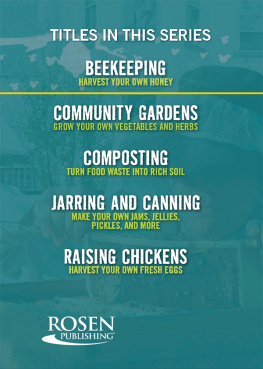This edition published in 2014 by:
The Rosen Publishing Group, Inc.
29 East 21st Street
New York, NY 10010
Additional end matter copyright 2014 by The Rosen Publishing Group, Inc.
All rights reserved. No part of this book may be reproduced in any form without permission in writing from the publisher, except by a reviewer.
Library of Congress Cataloging-in-Publication Data
Wanjie, Anne.
The Basics of genetics/by Anne Wanjie.
p. cm.(Core concepts)
Includes bibliographical references and index.
ISBN 978-1-4777-0552-0 (library binding)
1. GeneticsJuvenile literature. I. Title.
QH437.5 W36 2014
576.5d23
Manufactured in the United States of America
CPSIA Compliance Information: Batch #S13YA: For further information, contact Rosen Publishing, New York, New York, at 1-800-237-9932.
2004 Brown Bear Books Ltd.
CONTENTS
CHAPTER 1: GENETICS: THE STUDY OF HEREDITY
CHAPTER 2: PRINCIPLES OF INHERITANCE
CHAPTER 3: THE PROCESS OF CELL DIVISION
CHAPTER 4: FROM DNA TO RNA TO PROTEIN
CHAPTER 5: UNDERSTANDING GENOMES
CHAPTER 6: CONCEPTS IN HUMAN GENETICS
CHAPTER 7: APPLYING GENETIC KNOWLEDGE
CHAPTER 8: BIOGRAPHY: GREGOR MENDEL
GLOSSARY
FOR MORE INFORMATION
FOR FURTHER READING
INDEX
CHAPTER ONE
GENETICS: THE STUDY OF HEREDITY
What determines your height, hair color, ear shape, blood type, and every other feature of your body? The answer lies in your genes.
E verything about you, from the way you look to how your body functions, is controlled by genes. Genes are packets of information that form a code. You inherited your genes from your mom and dad. Genes occur on stretches of long chemicals called deoxyribonucleic acid, or DNA. Genetics is the study of how genes pass through the generations and the role of DNA and other chemicals.
Features such as the childrens eye and hair color depend on genes received from their mom and dad, although the environment in which they grow up can affect characteristics such as height and weight.
Most cells in your body have a control center called a nucleus. The nucleus contains all the genes needed to make your body and keep it working. An organisms complete set of genes is called its genome. DNA carrying the genes is organized into structures called chromosomes. Every species has a fixed number of chromosomeshumans have 46, for example.
GENETIC VARIATION
Take a look at the other children in your class. Why are there several different hair colors? Hair color is produced by pigments inside the hairs. Pigments are made by chemical reactions inside cells. Different pigments are made by different reactions, and each needs the help of an enzyme. People with different hair colors have different combinations of genes. The various combinations lead to the production of different enzymes.
DNA IS PACKAGED IN A CHROMOSOME
DNA: AN IMPORTANT MOLECULE
Genes are sequences of chemicals called bases on a very special moleculeDNA. Life as we know it could not exist without DNA. Genes on a DNA molecule work by driving the production of chemicals called proteins in the cell. Proteins may be products such as hormones. Proteins also include enzymes, without which chemical reactions inside the body could not take place. To make proteins using DNA, a similar chemical, RNA, is needed.
A scientist looks at a persons DNA profile. Advances in our understanding of genetics allow scientists to carry out DNA fingerprinting, a valuable technique in police work as well as in biological research.
HEREDITY VS. ENVIRONMENT
Not every feature is exclusively determined by genessome are affected by the environment. For example, weight can be affected by how many calories a person eats and how much exercise they do. Similarly, characteristics such as intelligence and criminal tendencies might be linked to genes, but they may also be affected by how an individual was raised. So which is more important genes or the environment?
INHERITING TRAITS
Half of the 46 chromosomes inside each cell in your body are provided by your mom; the other half come from your dad. Male sex cells, or sperm, carry one set of chromosomes. Female sex cells, or eggs, carry the other. A sperm and an egg come together in a process called fertilization. That forms a cell called a zygote. You and everybody else started life as a zygote. The chromosome sets provided by your parents began to work together there. Thats what makes you you.
The genes carried on the chromosomes tell your cells what color your eyes are and what size your nose is; every feature of your body is shaped by genes. Each feature, though, is coded for by two versions of a gene, one from your mother and one from your father. The paired genes are called alleles. Sometimes both alleles are the same, but different versions may be present. How does the body know which set of genetic instructions to follow?
The answer is that some alleles are dominant: The trait they code for is always shown when the alleles are present. Other alleles are recessive. Recessive alleles only come into effect in the absence of dominant alleles.
COPYING AND DIVIDING
After the zygote that would become you was formed, the cells divided again and again. This cell division continued as you developed. Some types of cells stopped dividing soon after you were born. Others will divide for the rest of your life, to repair wounds, for example. When a cell divides, the new cells it creates need new sets of chromosomes.
A process called mitosis creates accurate DNA copies that go from cell to cell. That ensures every cell in your body has the same set of genes to work with.
Things are different when the sex cells are being made. Like other cells, sex cells form through cell division, and DNA copies need to be made. However, the resulting sex cells must have only 23 chromosomes rather than 46. Also, the DNA is mixed up a little to make new combinations of genes, increasing genetic diversity. The process of sex cell production is called meiosis.
GENE REGULATION
Almost every cell in your body has the same set of genes. That is because DNA is copied every time a cell divides. But how can cells, such as muscle cells and brain cells, end up doing different jobs? Genes are switched on or off depending on where they are in the body, and what stage in their development they have reached. So, muscle cells contract, and brain cells carry nerve impulses despite their having identical genes.
ADVANCES IN BIOTECHNOLOGY
Scientists use their knowledge of genetics to change the characteristics of organisms. Plants and animals can be selectively bred for useful feature. In recent years crops and animals have been genetically modified (altered) to protect against pests or to increase yields. Genetically modified organisms are also useful in medicine, in the production of the hormone insulin. Understanding inheritance helps physicians figure out the likelihood of genetic disorders such as hemophilia occurring.

















